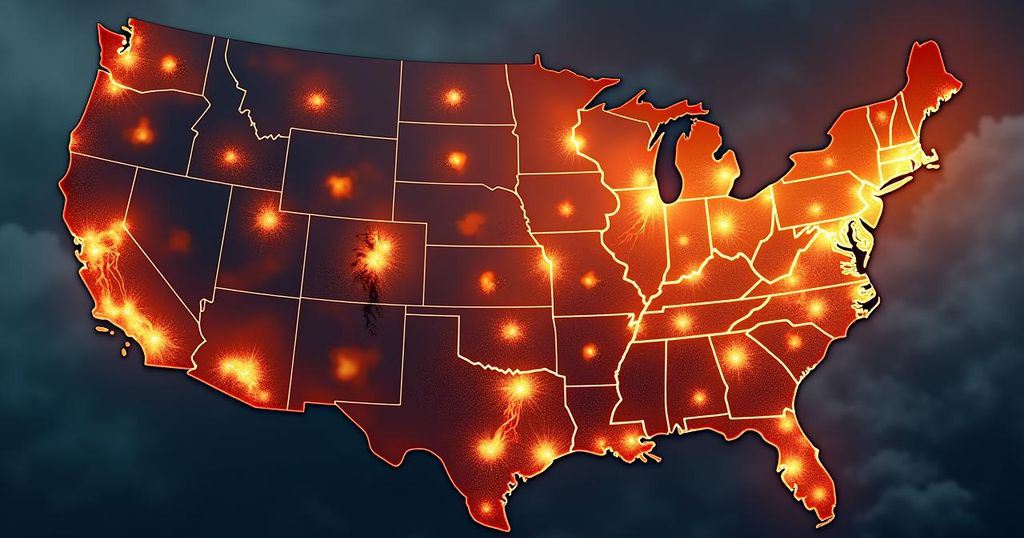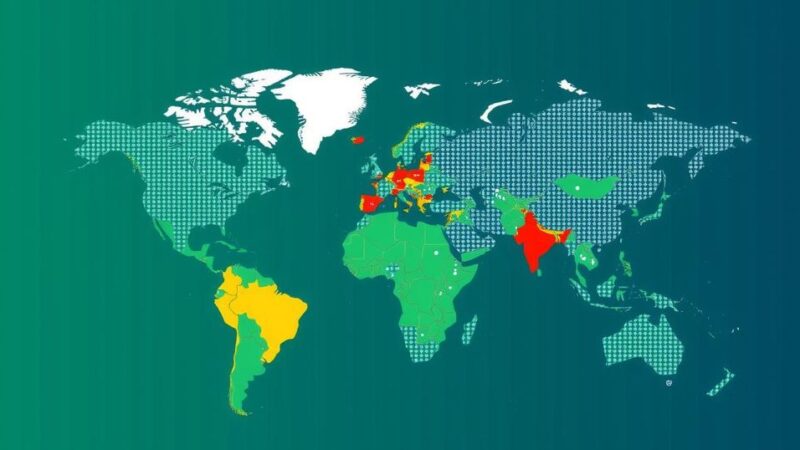Recent reports reveal that every region in the U.S. faces threats from climate-related storms and wildfires. Hurricane Helene caused significant destruction across Florida and the eastern U.S., resulting in over 180 deaths and extensive economic impacts. Experts highlight that infrastructure inadequacies, rising populations, and increasing disaster costs necessitate urgent strategies for climate resilience and readiness.
Recent analyses indicate that no region in the United States is impervious to the devastations wrought by climate-induced storms and wildfires. Despite warnings from meteorologists regarding the potential havoc of Hurricane Helene, the storm’s landfall in Florida and subsequent path through the eastern United States resulted in over 180 fatalities and catastrophic damage, shocking many despite prior forecasts. Regions such as Florida’s Big Bend, which had gone decades without a hurricane strike, have seen multiple severe events within a short timeframe. Similarly, even areas in North Carolina, previously deemed relatively safe from extreme weather, are now grappling with extensive flooding. As natural disasters become more frequent and increasingly harmful, the implications of climate change are becoming glaringly evident. Enhanced global temperatures elevate atmospheric moisture and energy levels, leading to more extreme weather events that coincide with established communities filled with valuable properties and lives at risk. Mari Tye, a scientist at the National Center for Atmospheric Research, highlights the vulnerability of coastal populations and aging infrastructure, stating, “Pretty much 50% of the population lives within miles of the sea, more exposed to hurricanes and with an aging infrastructure that is not set for today’s climate.” In North Carolina, the annual average of billion-dollar disasters has escalated sharply, from one or two per year in the late 20th century to an alarming six or seven recently. The state’s population growth further complicates matters, with approximately 400,000 newcomers added since April 2020. Residents impacted by Hurricane Helene face prolonged outages of essential services while recovery from the widespread devastation poses substantial challenges. Ken Buell from the U.S. Energy Department noted the complexity of restoration efforts owing to the extensive damage. He indicated, “In some areas, we are looking at an expedited rebuild of the energy system or a rebuild of the entire community before power can be restored.” The reality is that many infrastructural systems were initially designed for climates that are changing drastically and may no longer withstand increasingly volatile weather patterns. As the costs of weather-related disasters continue to escalate, with estimates suggesting Hurricane Helene may result in damages exceeding $250 billion, a significant burden falls upon the shoulders of local and federal aid systems. Texas, historically the epicenter of extreme weather, exemplifies this crisis, tallying 186 disasters costing over $1 billion since 1980. The recently intensified natural calamities—including wildfires, hailstorms, and hurricanes—highlight a trend of rising economic impacts due to climate change. Scientists attribute the increase in severe weather phenomena to rising global temperatures and carbon emissions. According to marine and climate scientist Deborah Brosnan, the atmosphere now holds approximately 7% more moisture for each degree of warming, fueling the intensity of storms and drought-related challenges. Jennifer Francis of the Woodwell Climate Research Center pointed out that warm oceans provide hurricanes with more energy, causing them to produce devastating impacts farther inland. The convergence of drought, heatwaves, and escalating weather extremes has strained agricultural systems, utilities, and human populations alike, as they endeavor to adapt to new climatic realities. Daniel Swain, a climatologist, emphasized the urgency of recognizing and preparing for the unforeseen severity of storms like Hurricane Helene, stating that the threshold for potential disaster has significantly shifted. In conclusion, the data presents a stark picture where the interaction between climate change and extreme weather events has resulted in a heightened state of vulnerability across the United States. As communities unite to support victims of Hurricane Helene and similar disasters, it becomes increasingly critical to engage in dialogues regarding readiness for climate-related threats, acknowledging that the ramifications of climate change are undeniably central to these discussions.
The article discusses the growing threat of climate-fueled storms and wildfires in the United States, emphasizing that no location is entirely safe from such challenges. It references Hurricane Helene as a recent case study, illustrating the extensive damage and loss of life caused by extreme weather events, which are becoming more frequent due to global warming. The narrative highlights the inadequacies of aging infrastructure, burgeoning urban populations, and the escalating financial toll of these disasters, underscoring the urgent need for enhanced resilience and disaster preparedness at community and governmental levels.
In summary, the rise in severity and frequency of climate-related disasters, such as Hurricane Helene, elucidates a critical need for awareness and action regarding climate preparedness in the United States. Vulnerable populations, aging infrastructure, and escalating costs point towards an urgent need for handling the realities of an evolving climate, necessitating comprehensive strategies to mitigate risks associated with extreme weather conditions. The convergence of climate change with storm and wildfire dynamics presents an unprecedented challenge that must be addressed to safeguard lives and properties throughout the nation.
Original Source: phys.org






